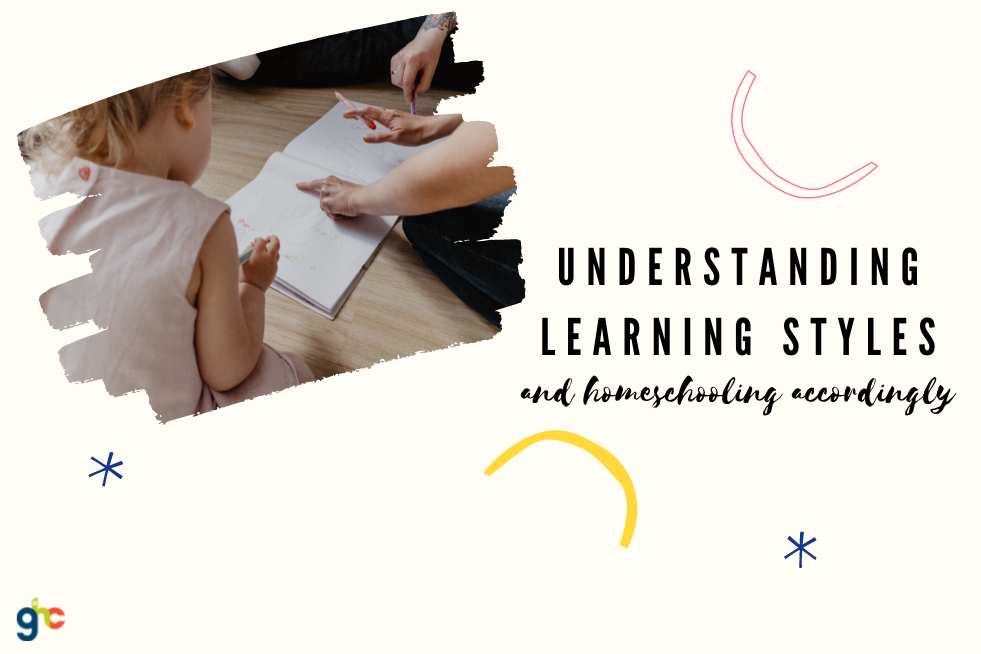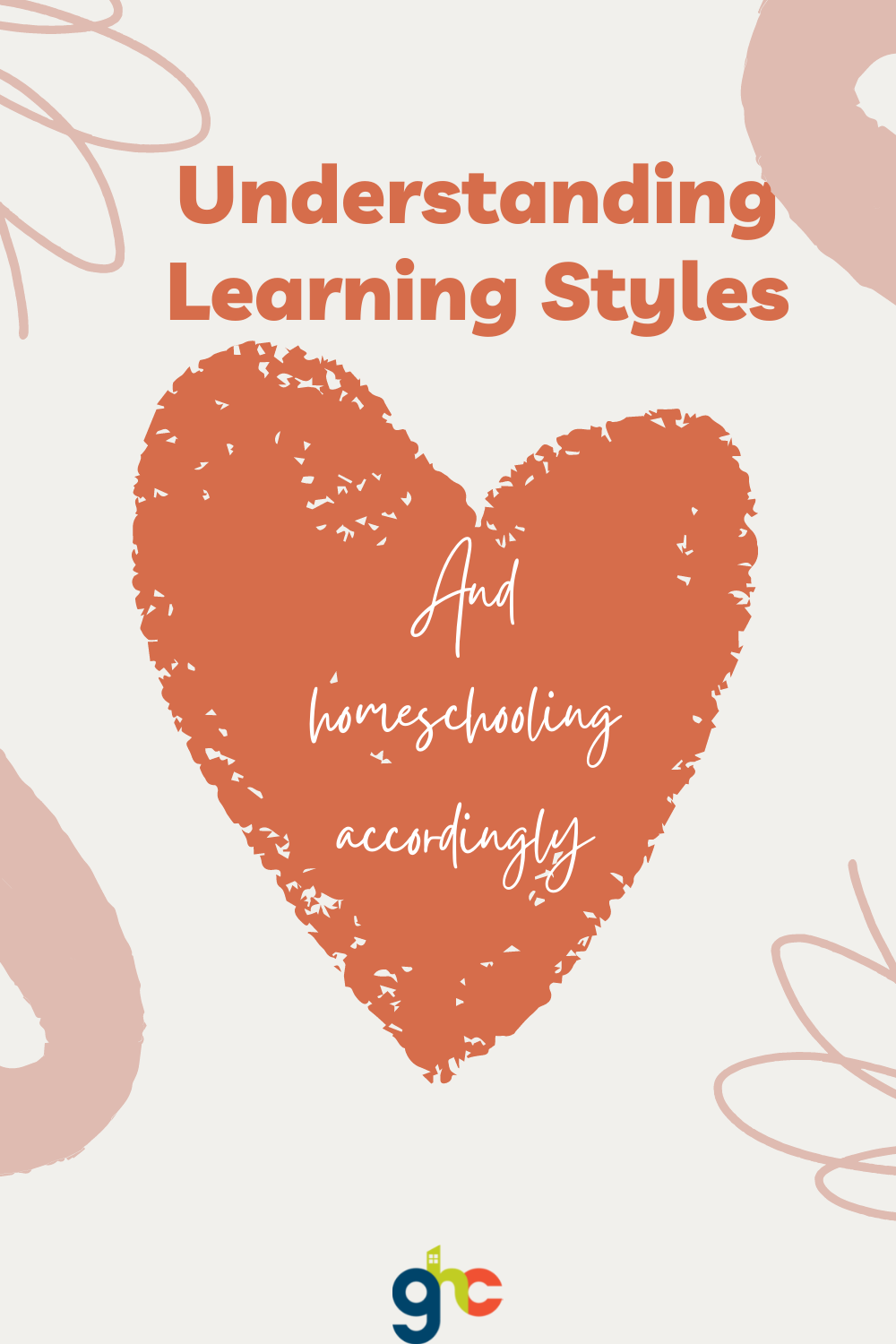Everyone learns differently, and for those of us who homeschool, it can be helpful to determine some of the ways each of your children processes and retains information. Doing so can help make your job as a teacher easier, for one, but it can also reduce your child’s frustration and set them up for success. All students' learning styles are different, this article is to help you figure out what is best for your child!
When we talk about different learning styles, we are referring to the way someone processes, comprehends, and retains information. There are many theories about learning styles, but we’ll focus on the seven most common styles. The first four are based on the Vark model, which stands for visual, auditory, reading/writing, and kinesthetic. It was developed by a teacher named Neil Fleming in New Zealand. The last three styles are from the developmental psychologist Howard Gardner’s theory of Multiple Intelligences.
One important thing to mention is that you shouldn’t feel like you have to adhere to teaching in a way that only caters to one individual learning style. In fact, according to an article on learning styles by Vanderbilt University, it may even help children strengthen their abilities in other learning styles if you try different ways of teaching. Certain subjects are also conveyed better with a particular type of teaching style. For example, students would no doubt learn more from a hands-on approach for sculpting and art rather than an auditory lesson.

Common Learning Styles and How to Homeschool Accordingly
Visual
This is the first type of learning style according to the Vark model, and these types of learners do best when they can see images, charts, diagrams, or other visual models to help them understand the learning concept.
Students with a visual learning style prefer:
- To draw things
- Paper handouts with pictures
- Maps, diagrams, and charts
- Detecting patterns
- Interesting page layouts or styles
- Using color and shape
- Illustrations
- Artistic activities
How to Homeschool Accordingly
For visual learners, you’ll want to choose a curriculum that will capture their attention with colors, patterns, and even interesting fonts.
When homeschooling, here are some things to consider:
- Choose lesson plans and workbooks that make use of images, patterns, and color
- Choose lesson plans and books that make use of diagrams and charts
- Use maps and the globe even in subjects like history so that your student can better picture where the events are taking place
- Draw things on a whiteboard or chalkboard to better illustrate a point
- Make use of charts, diagrams, and flowcharts on the board to help your student better understand complex concepts
- Use as many visual aids as you can find!
Auditory
Auditory learners, also known as aural or verbal learners, respond best to sound and music, talking and listening.
Students with an auditory learning style prefer:
- Music
- Learning through talking and discussion
- Humming, singing, or talking to themselves while doing schoolwork
- Learning through rhymes or sing-alongs
How to Homeschool Accordingly
For auditory learners, you’ll want to think of ways to impart information to your students that take advantage of speaking out loud, music, or rhymes.
When homeschooling, here are some things you can do:
- Use music and sing-alongs to help children learn facts
- Use rhymes to help them remember
- Give verbal instructions
- Talk through concepts your child is struggling with
- Have verbal Q&A sessions with your child for different subjects
- Use audiobooks to help with reading comprehension, or read aloud
- Spell and define words out loud
Reading/Writing
These are children who learn and retain information best by reading and writing.
Students who are reading/writing learners prefer:
- To write and read as much as they can get their hands on
- To use lists and to order things into categories
- To take notes
- To write stories
- To write down instructions
How to Homeschool Accordingly
This is one of the best learning styles as so many subjects are reading and writing intensive. You can further help your students by allowing them to write down instructions.
Here are some other things to consider:
- Encourage them to write out study notes by hand
- Make flashcards to help the studying process
- Have them create checklists to guide studying
- Have your child teach the material to you (or their siblings) after they’ve learned it
- Have them explain concepts in writing
- Write out instructions or complex concepts on the board
Kinesthetic
Kinesthetic learners like to use all their senses (especially touch) to learn about the world around them. They learn best by doing--by putting things into practice.
Students with a kinesthetic learning style prefer:
- Using hands-on approaches
- Relating what they’ve learned to their own lives
- Watching videos to understand concepts
- Field trips, laboratory experiments, and building
- Doing things with others
- Demonstrations followed by applying what they’ve learned
- Learning by trial and error
- Looking for opportunities to apply what they’ve learned
How to Homeschool Accordingly
Kinesthetic learners like the chance to apply what they’ve learned in real-life scenarios, so even when you cannot do something physical to explain a concept, you can help them by connecting the concept in some way to their lives.
When homeschooling, consider:
- Going on a field trip that gives a real-life demonstration of what you’ve been learning
- Role-play scenarios
- Multimedia lesson plans, combinations of videos with some reading and writing
- Watching videos together that show those concepts (I especially love looking up videos of the most notable destinations in a particular country for geography)
- Doing experiments or attend laboratory sessions
- Looking at exhibits, pictures, or samples together
- Using hands-on approaches
- Utilizing physical objects as much as possible (like cutting out numbers in math or using counting sticks)
- Using building models
- Taking note of real-life scenarios
Logical-mathematical
Logical-mathematical learners like reason, logic, and order. These logical learners are typically very methodical and like things to be a lot like math: orderly and predictable.
Students with a logical-mathematical preferred learning style prefer:
- Numbers and patterns
- Order and logic
- Organization and categories
- Charts, diagrams, and lists
- Visual materials
- Using computers
- Hands-on projects
- Goal-oriented projects
- Troubleshooting and using logic to figure out complex problems
How to Homeschool Accordingly
Logical-mathematical learners like to be taught using computers, numbers, hands-on projects, and goal-oriented activities. They also appreciate structure and organization.
If you have a student like this at home, then consider:
- Helping your child identify patterns and breaking things down step by step
- Organizing and categorizing information: charts, diagrams, and lists can help them understand information better
- Making use of the computer
- Making your activities structured and goal-oriented
- Making your activities hands-on
- Talking about the statistics involved in each of the concepts
Social
The social (or interpersonal) learning style is one that can accompany any of the previous learning styles. This is one where the student prefers to learn in a group setting.
Students with a social learning method prefer:
- Role-playing
- Group projects and experiments
- Group Discussions
- Giving and receiving feedback
- Learning through interaction
- Leadership activities
How to Homeschool Accordingly
It can be tricky to homeschool a student who has a social learning style, particularly if you have an only child. For those with siblings, you can engage in group activities and learning when possible. If you have an only child, take advantage of a local homeschooling co-op. Co-ops are a fantastic option for social learners, even if they have lots of siblings at home.
If you have a student at home who prefers their learning in a social environment, then try:
- Offering lots of discussion and role-playing while teaching
- Teaching more than one of your children the same subject at once (i.e. religion, science, reading, etc)
- Attending a homeschool co-op
- Finding outside educators to teach a small lesson (ex. a doctor for a health lesson or a chef for a home economics lesson)
- Attending field trips with other homeschool families
- Attending laboratory sessions with other homeschool families (this gives you a break from having to do science experiments at home, too)
- Signing them up for extracurricular activities that fulfill this need in them--whether it’s sports, art, drama, or music
Solitary
The solitary (or intrapersonal) learner likes to study, set personal goals, and work alone.
Students with a solitary learning style prefer:
- Doing projects on their own
- Studying on their own
- Reading and writing
- Setting personal goals
- Activities--like workbooks--where they can just read and do the work independently
How to Homeschool Accordingly
Having a solitary learner can seem like a great match for an only child, but there are ways to allow this type of student to have independent study even if they have lots of siblings.
To best help your solitary learner feels comfortable in a homeschool environment, you can:
- Choose a curriculum that allows for plenty of independent study
- Make a pile of the work your student can do independently on one side of their desk, and a pile of work that you need to go over together. That way they have the chance to do their work by themselves.
- Let your student keep track of his/her own goals
- Assign reading and writing-intensive work
- Make sure they have their own space--their own desk or corner to work
- Give them the chance to research and figure things out on their own
How to Identify the Learning Style of Your Child
Because humans are complex beings with individual thoughts and preferences, we don’t always fit neatly into categories. Everybody will process information differently, finding that style can be crucial for learning effectively. You may find that your child has traits from more than one specific learning style--and that’s completely normal! It’s natural to have our strengths, and that includes learning styles.
As you read over each style, it may be helpful to check off or write down the traits your child has from each learning style, so that you can incorporate that into your homeschooling sessions.
If you’re wondering how to identify what type of learner your child is, then here are some things to look for, according to each learning style:
Visual
- Your child excels in art
- Your child enjoys books with lots of interesting things to look at--fonts, graphs, charts, maps, illustrations, etc
- Your child is good at recognizing and recalling people, words, and places that they’ve seen or read about before
- Your child is very interested in the world and objects around them (very observant)
- Your child does best when you provide them with a written example of the activity you want them to work on
Auditory
- Your child excels at music
- Your child frequently talks to themselves, hums, or sings when playing or doing schoolwork
- Your child does well when you give verbal instructions
- Your child enjoys talking and having discussions
- Your child listens well and likes to listen to all the instructions before starting a task
- Your child asks lots of questions
Reading/Writing
- Your child loves to read books and write stories
- Your child often writes things down or takes notes
- Your child remembers things best after they’ve read about them and written things down
- Your child works best when they’re alone in a quiet space
- Your child does best at following activities when they’ve written down the instructions for a task
Kinesthetic
- Your child excels at physical activities (sports, dance, gymnastics, etc)
- Your child has difficulty sitting still while learning
- Your child loves hands-on activities
- Your child likes to do activities such as using manipulatives in math or drawing and painting in art
- Your child likes to jump straight into a task and get started
- Your child likes to learn by doing rather than listening or reading
Logical-Mathematical
- Your child asks a lot of questions to learn about the subject
- Your child enjoys math and science best of all
- Your child likes to create goals for themselves
- Your child wants to understand the whole picture in any given task
- Your child loves charts, graphs, and other organizational tools
- Your child enjoys working with computers
Social
- Your child prefers to learn in a group setting
- Your child loves socializing and talking with others
- Your child asks lots of questions and likes to engage with you while learning
- Your child excels at group sports and other group extracurricular activities
- Your child loves to brainstorm with others
- Your child enjoys field trips and other group-learning situations
Solitary
- Your child tends to be independent and introspective
- Your child likes to spend time on their own, reading, writing and studying
- Your child likes to do independent study activities
- Your child enjoys workbooks that allow them to do their work on their own
- Your child prefers to study quietly
- Your child often seems shy in group settings
Now that you’ve hopefully pinpointed which learning style(s) your child fits into best, it’s important to also consider adding in elements from the learning styles your child is weaker in. For example, if you have a child who exhibits traits from the reading/writing and solitary learning styles, you may also want to make an effort to expose them to some group activities that utilize hands-on activities. Doing so will help make the uncomfortable scenarios more familiar, which will then prepare them for adulthood. Because--let’s be honest--most of the scenarios we find ourselves in in adulthood are uncomfortable to some degree!
We want our children to be flexible and confident in any situation. So while you’ll want to allow them to excel in the learning style they most exemplify, you don’t want to completely ignore the other learning styles. For example, you don’t want to focus so much on visual learning--writing down everything--that you don’t ever give verbal instructions. Efforts should be made to use a variety of learning skills.

In Closing
If you know which type of learning style your child is most drawn to, then you can keep that in mind while you homeschool. You can choose a curriculum that you know will most appeal to that learning style, and you can incorporate teaching techniques and materials that will help your child succeed.
There are many types of learning styles, but we chose to focus on the seven most common: visual, auditory, reading/writing, kinesthetic, logical-mathematical, social, and solitary. Each of these learning styles comes from a researched theory on the way people learn.
It’s not unusual for your child to have traits from more than one of the learning styles, and some of the styles compliment each other (like reading/writing and solitary, for example). If you aren’t sure which learning style your child most resembles, then be sure to use the “How to Identify What Type of Learner” section as a checklist for your child the next time you’re thinking about how they behave like a student.
Lastly, don’t feel as though you have to strictly cater to one type of learning style over the others, even if your child clearly falls into one particular category. Homeschooling is often about providing curriculum and instruction for more than one child at once, and you don’t want to stifle the natural flexibility that comes from a variety of teaching methods. So do what you do best as a homeschool teacher: help your children excel by giving them a balance of familiarity and challenges.
